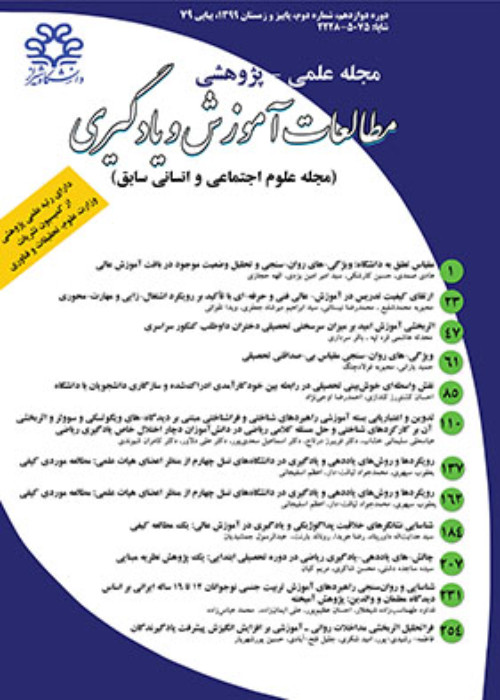The Effect of Blended Learning Approach on Learner's Success and Satisfaction in Technical/Vocational Education
Author(s):
Abstract:
Introduction Today, more than ever, it is important that learners be kept up-to-date. New information is available almost constantly, and learners must have access to that. On the other hand, in recent years workplace learning has embraced technology to meet the demands of continuing professional development and general training of employees. The major benefits of E-learning as an approach of using technology in education from both academic institutions and the corporate training area are well documented: (1) accurate and consistent content delivery through visuallyenhanced multimedia presentation and simulation, (2) self-paced and learner-controlled learning via dynamic content, (3) learner engagement through interactive learning materials, graphical modeling, and instant feedback, (4) real-world-like practices enabled by virtual labs, simulation, and interactive exercises, (5) accommodation of a variety of learning styles, (6) high retention of content through personalized and active learning, (7) content delivery efficiency, (8) anytime and anywhere learning modality, and (9) meaningful assessment and testing. But recently this learning approach has been criticized, and blended learning was suggested as an alternative approach. Blended learning is often defined as the combination of face-to face and online learning. Some researchers argue that this is not a sufficient definition for blended learning as it simply implies bolting technology into a traditional course, using technology as an add-on to teach a difficult concept or adding supplemental information. They suggest that blended learning should be viewed as an opportunity to redesign the way the courses are developed, scheduled and delivered in education through a combination of physical and virtual instruction. The goal of these redesigned courses should be to join the best features of in-class teaching with the best features of online learning to promote active, self-directed learning opportunities for students with additional flexibility. In spite of the importance of this approach in the research literature, little research however has been undertaken to assess the effectiveness of these methods. Hence, this study aimed to investigate the effect of blended learning on learner's success and satisfaction in technical and vocational education.
Research questions
1- Is there any significant difference between student's post- test scores in face to face and blended learning approaches for the Building Management System (BMS) course?
2- Is there any significant difference between student's satisfaction scores in face to face and blended learning approaches for the Building Management System (BMS) course?
Method This research was a quasi-experimental design with control and experimental groups in the field of technical/vocational education. For effectiveness of instructional approaches, two groups (control (N=19) and experimental (N=18)) of learners were selected randomly at Building Management System (BMS). Before training, a pre-test was conducted for two groups, and then they were both taught by the same trainer and given the same material pertinent to the course content. The groups were taught by deferent formats; in the control group, instruction was conducted through face to face approach by instructors (i.e., via lecturing). For the experimental group, instruction was fulfilled by mobile application in addition to face to face learning. So, in this group the content was presented by E- texts. For effectiveness of instructional approaches, the learner's satisfaction and instructional outcomes were measured. Instruments of research were a questionnaire in addition to a pre- test, and a post- test.
Results The research results showed that the blended learning approach was effective in improving learners educational achievements and satisfaction in comparison with face to face learning approach.
Conclusion This study has shown that using blended learning approach is the most appropriate approach in the training of learners in technical/vocational education. Learner's satisfaction increased under blended learning approach. Composition of trainer and technology use can be attractive for learners. Under blended learning students can negotiate, ask questions, and receive feedback from their teachers. On the other hand, by using E-texts they can have more durable pedagogical experiences. As a result, composition of trainer and the use of technologies can enhance learning outcomes in blended learning approach rather than other approaches. Based on research findings, it is suggested that instead of using a one-dimensional approach in training, such as face to face or E-learning approaches, the blended learning approach should be used in educational contexts.
Research questions
1- Is there any significant difference between student's post- test scores in face to face and blended learning approaches for the Building Management System (BMS) course?
2- Is there any significant difference between student's satisfaction scores in face to face and blended learning approaches for the Building Management System (BMS) course?
Method This research was a quasi-experimental design with control and experimental groups in the field of technical/vocational education. For effectiveness of instructional approaches, two groups (control (N=19) and experimental (N=18)) of learners were selected randomly at Building Management System (BMS). Before training, a pre-test was conducted for two groups, and then they were both taught by the same trainer and given the same material pertinent to the course content. The groups were taught by deferent formats; in the control group, instruction was conducted through face to face approach by instructors (i.e., via lecturing). For the experimental group, instruction was fulfilled by mobile application in addition to face to face learning. So, in this group the content was presented by E- texts. For effectiveness of instructional approaches, the learner's satisfaction and instructional outcomes were measured. Instruments of research were a questionnaire in addition to a pre- test, and a post- test.
Results The research results showed that the blended learning approach was effective in improving learners educational achievements and satisfaction in comparison with face to face learning approach.
Conclusion This study has shown that using blended learning approach is the most appropriate approach in the training of learners in technical/vocational education. Learner's satisfaction increased under blended learning approach. Composition of trainer and technology use can be attractive for learners. Under blended learning students can negotiate, ask questions, and receive feedback from their teachers. On the other hand, by using E-texts they can have more durable pedagogical experiences. As a result, composition of trainer and the use of technologies can enhance learning outcomes in blended learning approach rather than other approaches. Based on research findings, it is suggested that instead of using a one-dimensional approach in training, such as face to face or E-learning approaches, the blended learning approach should be used in educational contexts.
Keywords:
Language:
Persian
Published:
Studies in Learning & Instruction, Volume:9 Issue: 1, 2017
Pages:
91 to 108
magiran.com/p1732226
دانلود و مطالعه متن این مقاله با یکی از روشهای زیر امکان پذیر است:
اشتراک شخصی
با عضویت و پرداخت آنلاین حق اشتراک یکساله به مبلغ 1,390,000ريال میتوانید 70 عنوان مطلب دانلود کنید!
اشتراک سازمانی
به کتابخانه دانشگاه یا محل کار خود پیشنهاد کنید تا اشتراک سازمانی این پایگاه را برای دسترسی نامحدود همه کاربران به متن مطالب تهیه نمایند!
توجه!
- حق عضویت دریافتی صرف حمایت از نشریات عضو و نگهداری، تکمیل و توسعه مگیران میشود.
- پرداخت حق اشتراک و دانلود مقالات اجازه بازنشر آن در سایر رسانههای چاپی و دیجیتال را به کاربر نمیدهد.
In order to view content subscription is required
Personal subscription
Subscribe magiran.com for 70 € euros via PayPal and download 70 articles during a year.
Organization subscription
Please contact us to subscribe your university or library for unlimited access!





